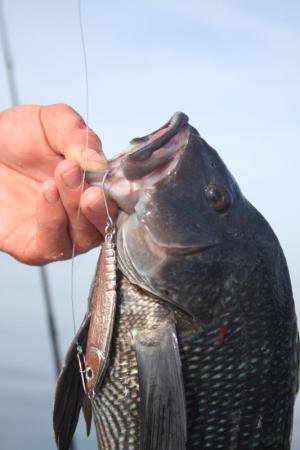This year, we are going to be releasing more fish than ever due to the new summer flounder regulations and the already established black sea bass rules. I also expect to see more weakfish or sea trout in the area, and with a bag limit of one fish and a 13-inch size limit, we are going to release a lot of those as well.
First, let’s look at tackle. If you are going to use bait, please use non-offset circle hooks. Then go a bit further and crush the barbs on those hooks.
If you have tried circle hooks in the past without success, you are doing something wrong. The way a circle hooks works is the bait must get inside the fish’s mouth; then, when the fish turns to swim away the hook will move along the inside of the mouth and lodge in the hinge or corner of the mouth.
All the angler has to do is keep a tight line, so when the hook hits the corner of the fish’s mouth, it will set. Yanking the line at the first sign of a bite will pull out the bait and the hook, before the hook can do its job. If your reflex is so well trained that you can’t resist yanking on the rod to set the hook, put the rod in a holder – and don’t pick it up until it bends over and almost touches the water.
Crushing the barb really doesn’t make much difference at first. So long as you keep steady pressure on the fish, the hook should stay on the corner of the mouth. However, once the fish is in the boat, hook removal is so much easier without the barb, and quickly releasing undersized fish is what you want to do.
When fishing for summer flounder, you will need to use a net with rubber-covered mesh. This will protect the fish from losing its protective mucus covering. If possible, remove the hook and release the flounder without taking it from the net. If you think it might be a keeper, have the measuring device ready, place the fish on the device as quickly as possible, and use a rag that has been soaked in bay or ocean water to handle the fish and either return it to the water or put in the cooler.
Never, ever put your hands inside the gills of any fish that may not be a keeper. I have to cringe when I see photos of folks with their hands up inside the gills of big striped bass with a caption that reads, “John Doe with a 50-inch striper that he caught and released.”
I am sure he released the fish. I am not sure it survived.
The best way to take a photo of your trophy fish is in the water alongside the boat. This is much less stressful than removing the fish from the water.
If you must haul out the fish, the next best thing is sitting down with the fish on your lap for a photo. That way the fish is supported, and you do not have your hands in its gills. There are fish grips available for a very reasonable price that you can use to hold the bottom of a fish’s mouth while you support the body with your lap.
If you have fished for black sea bass, you know how many short fish we have to return to the water. While this is a bonanza for the local seagull population, it just adds to the high release mortality of black sea bass.
The reason the seagulls can feast on the sea bass, besides the 13-inch size limit, is the extended air bladder that keeps the small sea bass on the surface where the birds can get to them. It is possible to puncture that air bladder and give the fish a chance to return to the bottom. Just a small hole can release the air, and it only takes a few seconds, so you won’t miss much fishing time. Any small, sharp object, such as a large sewing needle, will work.
Surf fishermen also need to be aware of release mortality. When we release small fish, we should walk them down to the surf and release them into deep water where they have a good chance of survival. Yes, that even includes sharks and skates.
Back in the day, I used to find piles of skates and sharks on the beach. I am happy to say I haven’t seen that in years, but treating them like trash is not a good idea. Others may be watching, including young people, and such activity leaves a lasting impression.
Release mortality is a real problem, and the more we can do to reduce it, the better future we will leave for those who follow.
























































